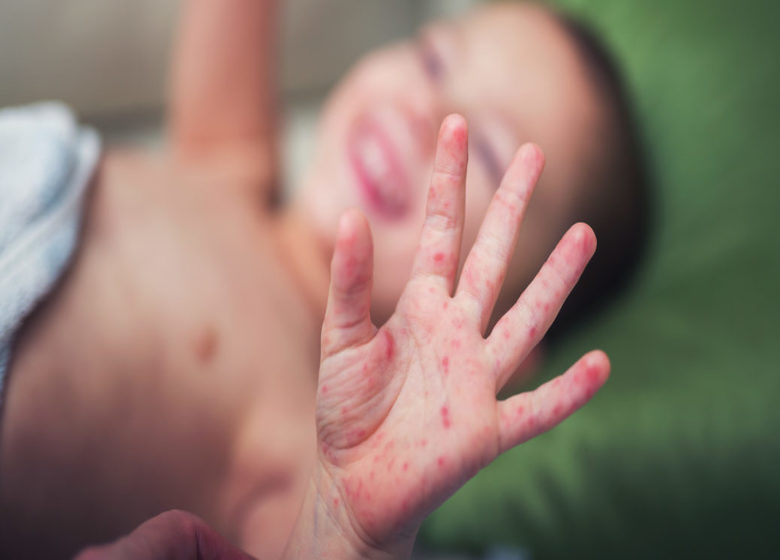Little kids are still on an exploration spree and don’t think twice about picking stuff up from the floor, putting them in their mouth and chewing them. It raises the child’s chance of getting infected by bacterial and viral diseases. One such disorder is HFMD (Hand, Foot, and Mouth Disease). Let’s look at the HFMD signs, causes, and treatments to help you understand better how to treat affected children.
What is Hand, Foot and Mouth Disease?
Hand, foot and mouth disease is an infectious infection that affects children aged 2-6 years. Affected children get sores on their hands, mouth, and feet as they are in contact with objects containing dangerous bacteria and viruses. Adults can often suffer from this disease if their immune systems are not too good.
Causes Of Hand, Foot And Mouth Disease in Babies
The following viruses may be the primary cause of HFMD:
- Coxsackievirus A16, A 10 or A6
- EV-71 or Enterovirus 71 or EV 71
The Picornaviridae family contain these viruses and they are infectious. Adults with this condition were also found to have suffered during infancy. Owing to the warm weather it spreads more easily in autumn and summer.
Doctors think the virus travels first into the tissue within the mouth, near tonsils, and then into the digestive system. This passes through the glands or lymph nodes and through the blood into the bone. The immune system protects vital organs like the brain from consuming the virus.
Symptoms of Hand, Foot and Mouth Disease In Babies
HFMD starts with fatigue, loss of appetite, vomiting, nausea, sore throat and irritability in infants.
The child develops blister-like sores in the mouth one or two days after the fever–particularly on the sides of their tongue, gums, in the back of their mouth, or the inside of their cheeks. The pains, discomfort, and irritation of the child are painful. Because of painful sores, the child may refuse to eat or drink. They can also happen on palms of the hands, feet’ sole, and sometimes on the buttocks. The rashes tend to be small, dry, red spots, and blisters later. They’re sore, but not prickly.

Image Source – BETADINE SINGAPORE
How Does HFMD Spread?
HFMD is an infectious disease that is highly contagious. It can spread by people infected by the virus within a week after the symptoms appear. Here are some of the ways the disease will spread:
1. Contaminated Droplets
Children are often infected by inhaling airborne contaminated droplets, particularly when an infected person is sneezing or coughing. If the virus is present in the air, the infant is likely to get infected by breathing.
2. Saliva
One of the most common forms of transmitting HFMD is through an infected person’s saliva. Children share the food and always eat with the same spoon and drink the same bottle of water. It raises the likelihood of being infected with saliva.
3. Faeces
The virus may be found in the infected person’s faeces for up to four weeks after the HFMD symptoms have gone away. But kids will catch it in classrooms, child care centers, and other areas where nappies are changed.
4. Blister
When the child comes into direct contact with the fluids coming out of the blisters of an infected person, HFMD may affect him or her.

Image Source – jamaicahospital.org
How long is HFMD going to last?
An infected person shows no immediate symptoms. It takes three to six days for the signs to turn up. The duration is referred to as the time of incubation. The disease begins with fever, and blisters begin to develop within a day or two. After a week, those blisters break and disappear. HFMD lasts from 7-10 days.
Diagnosis Of HFMD
Doctors monitor the signs and watch for rashes or blisters. Occasionally, the doctor may need a throat swab, urine, or blood sample to confirm the diagnosis of the disease.
Treatment
The infection occurs in most cases, without treatment. Treatment for hand, foot and mouth disease, however, can help ease discomfort. HFMD cure will include the use of:
- Medications to relieve pain, such as acetaminophen or ibuprofen
- For soothing blister use ointment
- Syrups or lozenges to relieve painful, sore throat
Prevention
There are no known medicines or vaccines against the viruses that cause HFMD. However, by adopting hygienic practices and providing medical care when needed, any kind of risk of infection can be minimized.
To prevent HFMD obey these measures:
- Clean your hands with soap in the following situations: after contacting an infected blister, before having a meal, before cooking, after cleaning and changing baby nappies
- Wash dirty floors and things such as clothing and toys using an effective disinfectant
- Avoid touching or kissing infected kids because it increases the risk of spreading the disease
- Avoid taking your infected kids to schools as it affects other kids
- Close your mouth while you are coughing and your nose while you are sneezing
- Dispose of soiled tissues and nappies into dustbins and keep the bins closed.
- Always, ensure clean childcare centers and schools
Complications
If you see HFMD-related symptoms, it is advisable to seek appropriate medical advice and care, if possible. The most common complication associated with HFMD is dehydration, as the mouth sores make it difficult to eat and drink. When left untreated, complications such as viral meningitis (inflammation of brain membranes and spinal cord ) and encephalitis (a life-threatening inflammation of the brain) can be caused by the disease. Though these complications are rare, be careful and seek advice from the doctor is advisable.
Mummies and carers must ensure proper cleanliness and hygiene when caring for children so that HFMD can be avoided. The above-mentioned signs, causes, and treatments will help you take sufficient steps to avoid and spread it.
Also Read: How To Make Homemade Hand Sanitizer













